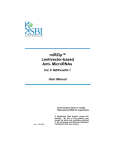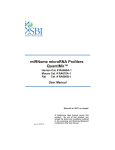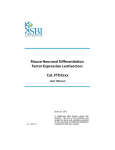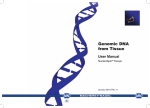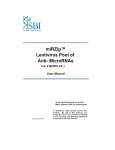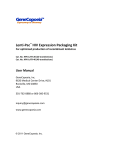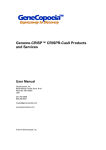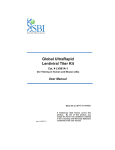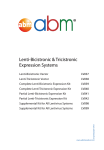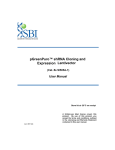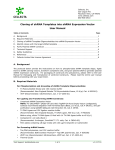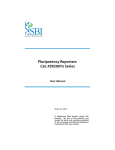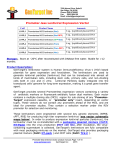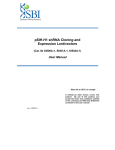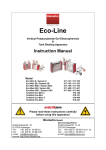Download User Manual
Transcript
miRZip™ Lentivector-based Anti- MicroRNAs Cat. # MZIPxxxPA-1 User Manual Grow bacterial stock on receipt Make plasmid DNA for experiments (ver. 1-081208) A limited-use label license covers this product. By use of this product, you accept the terms and conditions outlined in the Licensing and Warranty Statement contained in this user manual. miRZips™ Lentivector-based anti-microRNAs Cat. # MZIPxxx-PA-1 Contents I. Introduction and Background A. B. C. D. E. F. Purpose of this Manual Lentiviral miRZip Expression System miRZip™ shRNA Expression Lentivector List of Components Additional Required Materials Safety Guidelines II. How miRZips Work 2 2 2 4 4 5 6 III. Appendix A. Map and Features for miRZip™ Vector B. Related Products C. Technical Support 8 9 9 IV. Licensing and Warranty Statement 10 888-266-5066 (Toll Free) 650-968-2200 (outside US) Page 1 System Biosciences (SBI) User Manual I. Introduction and Background A. Purpose of this Manual This manual provides details and information for the use of miRZip™ anti-microRNA expression lentiectors. Specifically, it provides critical instructions on the lentivector design, the H1 expression cassette of the vector, and verifying the construct. This manual does not include information on packaging the miRZip™ construct into pseudotyped viral particles or transducing your target cells of choice with these particles. This information is available in the user manual Lentivector Expression Systems: Guide to Packaging and Transduction of Target Cells, which is available on the SBI web site (www.systembio.com). Before using the reagents and material supplied with this system, please read the entire manual. B. Lentiviral miRZip Expression System Short double-stranded RNAs with sizes 19-29 bp can efficiently mediate the delivery of small RNAs in mammalian cells. Synthetic single-stranded anti-microRNA molecules can be introduced into cells to suppress microRNA function transiently. Alternatively, miRZips can stably express anti-microRNAs and provide permanent microRNA inhibition—and in any cell type of choice. Lentiviral expression vectors are the most effective vehicles for delivering genetic material to almost any mammalian cell—including non-dividing cells and whole model organisms. As with standard plasmid vectors, it is possible to introduce miRZip lentivector constructs in plasmid form into the cells with low-to-medium efficiency using conventional transfection protocols. However, by packaging the lentiviral miRZip construct into pseudoviral particles, you can obtain highly efficient transduction and heritable expression of anti-microRNAs—even with most difficult to transfect cells, like primary, stem, and differentiated cells. The expression construct transduced in cells is integrated into genomic DNA and provides stable, long-term expression of the target gene. Endogenously expressed anti-microRNA effectors provide long-term suppression of the target microRNA and allow the researcher to generate cell lines and transgenic organisms with a stable microRNA inhibition phenotype for functional studies SBI offers a third generation of the most popular HIV-1 based lentivector expression system, consisting of three main components: (1) The lentiviral expression vector (e.g., miRZips™, pSIH1-H1-Puro™) (2) The lentiviral packaging plasmids (e.g., pPACKH1™ Packaging Plasmid mix) (3) A pseudoviral particle producer cell line (e.g., 293TN cells) The lentiviral expression vector contains the genetic elements responsible for packaging, transduction, stable integration of the viral expression construct into genomic DNA, and expression of the anti-microRNA effector sequence. The packaging vector provides all the proteins essential for transcription and packaging of an RNA copy of the expression construct into recombinant viral particles. For production of a high titer of viral particles, producer cells (e.g., HEK 293 cells) need to be transiently co-transfected with the expression and packaging vectors. Expression constructs packaged in pseudoviral particles are secreted by producer cells in culture media and could be used directly to transduce expression construct in target cells. Following transduction into the target cells, this expression construct is reverse transcribed, integrated into the genome of the target cell, and provides a high level of expression of anti-microRNAs. For a detailed description of SBI’s Lentivector expression system, please refer to the Lentivector Expression Systems: Guide to Packaging and Transduction of Target Cells user manual. C. miRZip™ shRNA Expression Lentivector The miRZip™ expression vector is based upon SBI’s pGreenPur™ lentivector, an improved third generation of HIV-based expression lentivector developed for gene therapy applications. See section F for safety guidelines. The miRZip™ vector (see detailed functional map in Appendix) provide the following features: • H1 expression cassette provides constitutive and efficient RNA polymerase III-dependent transcription of anti-microRNA transcripts in a wide range of cell lines. • CMV promoter promotes high level of expression of both copGFP (fluorescent reporter) and puromycin-Nacetyl transferase (drug selectable marker) in the same vector for detection and selection of either transduced or transfected cells. Page 2 ver. 1-081208 www.systembio.com miRZips™ Lentivector-based anti-microRNAs Cat. # MZIPxxx-PA-1 • Hybrid RSV-5’LTR promoter provides a high level of expression of the full-length viral construct in 293 cells. • Genetic elements (cPPT, GAG, LTRs) necessary for packaging, transducing, and stable integration of the viral expression construct into genomic DNA. • SV40 origin for stable propagation of the miRZip™ plasmid in 293 producer cells. • The pUC origin for high copy replication and maintenance of the plasmid in E.coli cells. • The ampicilin-resistance gene for selection in E.coli cells. • WPRE element enhances stability and translation of the CMV-driven transcripts. • The SV40 polyadenylation signal enables efficient termination of transcription and processing of recombinant transcripts. The miRZips™ and its parental, empty lentivector (pGreenPur™Cat. # SI505A-1) contain a puromycin resistance gene to enable drug selection of target cells stably expressing the anti-microRNA, and a copGFP gene. The copGFP is a novel fluorescent protein, derived from copepod plankton (Panalina sp.), which is similar to EGFP but has a brighter color. This gene serves as a fluorescent reporter for the transfected or transduced cells. The open reading frames of puromycin resistance and copGFP genes are connected by a T2A sequence and are transcribed from the CMV promoter as a bicistronic transcript. The two proteins are then separated through translational cleavage at the T2A site. Two approaches have been developed for in vivo expression of interfering RNAs from plasmid and viral vectors. In one approach, the sense and anti-sense strands are transcribed separately from two independent promoters and form the interfering RNA duplex. With the second approach, a single-stranded shRNA sequence with a foldback stem-loop structure (also known as a “hairpin”) is expressed from a single promoter. This sequence is then converted into double-stranded siRNA after intracellular processing cleaves the loop. In both approaches, the siRNA molecules are transcribed from constitutive RNA polymerase III promoters (i.e., U6 and/or H1) and terminated with TTTTT (T5) sequences. The U6 and H1 promoters are different in size but contain the same conserved sequence elements. Fig. 1. Design of the single-promoter miRZip™ shRNA anti-microRNA expression cassette. The dotted lines at the top of the figure indicate the position of the “stuffer fragment” that is removed during linearization by digesting the vector with BamHI/EcoRI. Your miRZip template sequence is directionally inserted between the BamHI and EcoRI nucleotide overhangs The miRZip™ Vector is designed to express a single-stranded shRNA sequence with a fold-back stem-loop structure (also known as a “hairpin”) from a RNA polymerase III H1 promoter. The hairpin-type siRNA (shRNA) template oligonucleotides need to be cloned into unique BamHI/EcoRI sites located just downstream of an H1 promoter (Figure 1). When the anti-microRNA construct is expressed from the constitutive H1 promoter and terminated with the TTTTT sequence, the shRNA transcript folds into the hairpin structure, which is recognized by the DICER enzyme and is processed to produce functional single-stranded anti-microRNAs. 888-266-5066 (Toll Free) 650-968-2200 (outside US) Page 3 System Biosciences (SBI) User Manual Each miRZip hairpin interfering RNA is designed to generate the full-length antisense microRNA for a specific, targeted microRNA. The target microRNAs are “zipped”. Fig. 2. Example shRNA anti-microRNA template construct. The nucleotides for the specific anti-microRNA sequence targeting the microRNA of choice are shown in capital letters. The shRNA sense and antisense sequences flank the region coding for the loop structure. In addition, a terminator sequence for the RNA polymerase III is included after the antisense portion. After transcription, a stem-loop-stem shRNA molecule is produced. This molecule is processed by the DICER enzyme to generate a double-stranded anti-microRNA effector. D. List of Components Each miRZip™ construct comes as a bacterial stock: Incubate your miRZip construct bacterial stock plate at 37°C overnight. Select 1 to 2 single colonies for construct propagation. Grow your construct in LB+Carbinicillin (or 50 μg/ml Ampicillin) overnight, shaking at 30°C. This is important to avoid potential, undesired lentivector recombination events. E. Additional Required Materials For Purifying miRZip Constructs after Propagation • Plasmid purification kit (Recommended: QIAGEN Endotoxin-free Plasmid Kit. The following kit combinations can be used for Midi scale preparation of endotoxin-free DNA: ¾ QIAfilter Plasmid Midi Kit, Cat. # 12243, and EndoFree Plasmid Maxi Kit, Cat. # 12362 ¾ QIAfilter Plasmid Midi Kit, Cat. # 12243, and EndoFree Plasmid Buffer Set, Cat. # 19048 Please visit the QIAGEN website to download the specialized protocol that is not contained in the user manual: ¾ http://www1.qiagen.com/literature/protocols/pdf/QP15.pdf Transfection of miRZip™ Constructs into Target Cells • Transfection reagent (Recommended: Lipofectamine™ 2000, Invitrogen, Cat # 11668-027) Packaging of miRZip™ Constructs in Pseudoviral Particles Page 4 ver. 1-081208 www.systembio.com miRZips™ Lentivector-based anti-microRNAs • • • • Cat. # MZIPxxx-PA-1 pPACKH1 Lentivector Packaging Kit (SBI, Cat # LV500A-1) 293TN Producer Cell Line (SBI, Cat # LV900A-1; or ATCC, 293T/17, Cat # CRL-11268) Lipofectamine™ Transfection Reagent ( Invitrogen, Cat # 18324-111) Plus™ Reagent (Invitrogen, Cat # 11514-015) F. Safety Guidelines SBI’s miRZip™ lentivectors together with the pPACKH1 packaging plasmids comprises a third-generation HIV-1based cloning vector system. These lentivectors are based on the vectors developed for gene therapy applications by Dr. J. G. Sodroski (US patent #5,665,577 and # 5,981,276). This system is designed to maximize its biosafety features including: • Deletion in the enhancer of U3 region of 3’LTR ensures self-inactivation of lentiviral construct after transduction and integration into genomic DNA of the target cells. • RSV promoter upstream of 5’LTR in miRZip™ expression vector allows efficient Tat-independent production of viral RNA, reducing the number of genes from HIV-1 that are used in this system. • Number of HIV-1 viral genes necessary for packaging, replication and transduction is reduced to three (gag, rev and pol), and these genes are expressed from different plasmids lacking packaging signals and significant homology to the miRZip™ expression vector, VSV-G expression vector, or each other to prevent generation of recombinant replication-competent virus. • None of the HIV-1 genes (gag, pol, rev) will be present in the packaged viral genome, as they are expressed from packaging plasmids lacking packaging signal--therefore, the lentiviral particles generated are replication-incompetent. • Pseudoviral particles will carry only the expression construct of your target gene. • The lentiviral particles produced in this system are pseudotyped with envelope G glycoprotein from Vesicular Stomatitis Virus. Despite the above safety features, use of HIV-based vectors falls within NIH Biosafety Level 2 criteria. For a description of laboratory biosafety level criteria, consult the Centers for Disease Control Office of Health and Safety Web site at http://www.cdc.gov/od/ohs/biosfty/bmbl4/bmbl4s3.htm. It is also important to check with the health and safety guidelines at your institution regarding the use of lentiviruses and always follows standard microbiological practices, which include: • Wear gloves and lab coat all the time when conducting the procedure; • All procedures are performed carefully to minimize the creation of splashes or aerosols. • Work surfaces are decontaminated at least once a day and after any spill of viable material. • All cultures, stocks, and other regulated wastes are decontaminated before disposal by an approved decontamination method such as autoclaving. Materials to be decontaminated outside of the immediate laboratory are to be placed in a durable, leakproof container and closed for transport from the laboratory. miRZip lentivector constructs can be used for both GFP sorting and Puromycin selection for stable cell lines. Phase contrast GFP fluorescence HEK-293 cells were transfected with empty miRZip™ anti-microRNA expression vector, and puromycin (50 μg/ml final concentration) was then added to the cells 24 hours after transfection. The pictures were taken 24 hour after the initiation of the puromycin treatment. 888-266-5066 (Toll Free) 650-968-2200 (outside US) Page 5 System Biosciences (SBI) User Manual II. How miRZips Work miRZip anti-sense microRNAs are stably expressed RNAi hairpins that produce mature anti-microRNAs. These miRZips antagonize its endogenous microRNA target and inhibit its function. The miRZip construct produces high levels of anti-sense small RNAs that target a specific microRNA. Upon binding, the miRZip provides a more stable template for the microRNA to bind to and sequestering it from participating in RISC-associated target mRNA translation inhibition. Transfection and Analysis of microRNA Suppression Efficiency If you are planning to use SBI’s miRZip™ anti-microRNA constructs for viral delivery, we recommend comparing efficiencies of several transfection procedures (e.g., Invitrogen’s Lipofectamine™ 2000, Cat. # 11668-027; Roche, FuGENE 6, Cat. # 11 815 091 001). The goal of these experiments is to achieve at least 90-95% transfection efficiency of target cells, which can be measured by analysis of GFP-positive cells. For microRNA suppression studies using transfection, it is important to optimize the selected transfection protocol and then keep the parameters constant to ensure reproducible results. Depending on what is appropriate for your target gene, the inhibition efficiency of different anti-microRNA constructs can be estimated by determining the amount of targeted mRNA repressed by the suppressed microRNA, assessing the amount of target protein by Western blot or ELISA, or assaying for activity of the target protein. Usually miRZip constructs with 70-80% inhibition efficiency are suitable for microRNA functional analysis studies. Page 6 ver. 1-081208 www.systembio.com miRZips™ Lentivector-based anti-microRNAs Cat. # MZIPxxx-PA-1 You can package this miRZip construct into pseudoviral particles, and efficiently transduce these anti-microRNA constructs into target cells of your choice. For this purpose, you will need to purchase the pPACKH1 Lentivector Packaging Kit (SBI, Cat. # LV500A-1) and 293TN Producer Cell Line (SBI, Cat. # LV900A-1). The pPACKH1 User Manual “Lentivector Expression Systems: Guide to Packaging and Transduction of Target Cells” includes the procedural information for packaging the shRNA lentivector constructs. This user manual is also available on the SBI web site (www.systembio.com). Although you can create stable transfectants with the miRZip™ constructs using standard transfection and selection protocols, transduction of the lentiviral miRZip™ anti-microRNA constructs using packaged pseudoviral particles is the most efficient way to express siRNA in wide range of cells, including dividing, non-dividing, and hard-to-transfect varieties. Selection of Stably Infected Cells: Because infected cells stably express copGFP and puromycin, as well as the anti-microRNA cloned into the miRZip™ vector, they can be selected either for GFP positive cells by FACS or for puromycin resistance cells by puromycin treatment. Since puromycin resistance can vary from cell type to cell type, we recommend you generate a killing curve of your target cells with different concentrations of puromycin in a 96-well plate, and then use the lowest concentration that can kill your target cells the next day after the addition of puromycin for selecting your infected cells. 888-266-5066 (Toll Free) 650-968-2200 (outside US) Page 7 System Biosciences (SBI) User Manual III. Appendix A. Map and Features for miRZip™ Vector pmiRZip 7861 bp Feature RSV/5’LTR Location* 7-413 gag RRE 566-920 1076-1309 cPPT 1806-1923 CMV promoter 1929-2278 copGFP 2293-3048 T2A 3049-3102 Puro 3103-3702 WPRE 3703-4291 3’ ∆LTR(∆U3) 4631-4813 H1 RNA promoter SV40 Poly-A SV40 Ori pUC Ori AmpR 4526-4616 Function Hybrid RSV promoter-R/U5 long terminal repeat; required for viral packaging and transcription Packaging signal Rev response element binds gag and involved in packaging of viral transcripts Central polypurine tract (includes DNA Flap region) involved in nuclear translocation and integration of transduced viral genome Human cytomegalovirus (CMV)--constitutive promoter for transcription of copGFP-T2A-puro Copepod green fluorescent protein (similar to regular EGFP, but with brighter color) as a reporter for the transfected/transduced cells Thosea asigna virus 2A translational cleavage site containing 18 amino acid residues. Cleavage occurs via a co-translational ribosome skipping mechanism between the C-terminal Glycin and Prolin residues, leaving 17 residues attached to the end of copGFP and 1 residue to the start of the puromycin resistance marker Puromycin-resistant marker for selection of the ransfected/transduced cells Woodchuck hepatitis virus posttranscriptional regulatory element-enhances the stability of the viral transcripts Required for viral reverse transcription; self- inactivating 3' LTR with deletion in U3 region prevents formation of replication-competent viral particles after integration into genomic DNA RNA polymerase III promoter for expression of anti-microRNA insert 4911-5219 4911-5219 5584-6252 6397-7257 (C) Transcription termination and polyadenylation Allows for episomal replication of plasmid in eukaryotic cells Allows for high-copy replication in E. coli Ampicillin resistant gene for selection of the plasmid in E. coli Page 8 ver. 1-081208 www.systembio.com miRZips™ Lentivector-based anti-microRNAs Cat. # MZIPxxx-PA-1 B. Related Products • Lentivector Packaging Kits For FIV-based Vectors: pPACKF1™ (Cat. # LV100A-1) For HIV-based Vectors: pPACKH1™ (Cat. # LV500A-1) Unique plasmid mixes that produce all the necessary viral proteins and the VSV-G envelope glycoprotein from vesicular stomatitis virus required to make active pseudoviral particles. Producer Cell Line 293TN (SBI Cat. # LV900A-1) transiently transfected with the packaging plasmids and an HIV-based lentiviral construct produce packaged viral particles containing the lentiviral construct of interest. • 293TN Human Kidney Producer Cell Line (Cat. # LV900A-1) For packaging of plasmid lentivector constructs. • Peg-it virus precipitation solution (Cat. # LV810A-1) Concentrate lentiviral particles 10- to 100-fold. • pGreenPur™ empty lentivector control (Cat. # SI505A-1) • Lentivector UltraRapid Titer PCR Kit (Cat. # LV960A-1 [for human cells], LV960B-1 [for mouse cells]) Allows you to measure copy number (MOI) of integrated lentiviral constructs in genomic DNA of target cells after transduction with any of SBI’s FIV or HIV-based lentivectors using qPCR. • Lenti-miR microRNA precursor clone collection (PMIRHxxx-PA-1many) Choose from an extensive collection library or have your pre-microRNA of choice custom built as a service. The collection will be expanded to include all known Human pre-miRNAs. • MicroRNA qPCR profiling systems – measure all Human or Mouse microRNAs from a single cDNA synthesis • QuantiMir microRNA (cat.# RA420A-1) and • miRNome Profilers (cats.# RA660A-1, RA670A-1) • Global MicroRNA Amplification & Cloning Kit (cat.# RA400A-1) Clone and amplify all small RNAs. C. Technical Support For more information about SBI products, to download manuals in PDF format, and to get vector map and sequence information, please use our web site: http://www.systembio.com For additional information or technical assistance, please call or e-mail us at: System Biosciences (SBI) 1616 North Shoreline Blvd. Mountain View, CA 94043 Phone: (650) 968-2200 (888) 266-5066 (Toll Free) Fax: (650) 968-2277 E-mail: [email protected] 888-266-5066 (Toll Free) 650-968-2200 (outside US) Page 9 System Biosciences (SBI) User Manual IV. Licensing and Warranty Statement Limited Use License Use of the miRZip™ anti-microRNA Expression Construct (i.e., the “Product”) is subject to the following terms and conditions. If the terms and conditions are not acceptable, return all components of the Product to System Biosciences (SBI) within 7 calendar days. Purchase and use of any part of the Product constitutes acceptance of the above terms. HIV Vector System This product is for non-clinical research use only. Use of this Product to produce products for resale or for any diagnostic, therapeutic, clinical, veterinary, or food purpose is prohibited. In order to obtain a license to use this Product for these commercial purposes, contact the Office of Research and Technology Ventures at the Dana-Farber Cancer Institute, Inc. in Boston, Massachusetts, USA. This Product or the use of this Product is covered by U.S. Patents Nos. 5,665,577 and 5,981,276 (and foreign equivalents) owned by the Dana-Farber Cancer Institute, Inc. WPRE Technology System Biosciences (SBI) has a license to sell the Product containing WPRE, under the terms described below. Any use of the WPRE outside of SBI’s Product or the Products’ intended use, requires a license as detailed below. Before using the Product containing WPRE, please read the following license agreement. If you do not agree to be bound by its terms, contact SBI within 10 days for authorization to return the unused Product containing WPRE and to receive a full credit. The WPRE technology is covered by patents issued to The Salk Institute for Biological Studies. SBI grants you a non-exclusive license to use the enclosed Product containing WPRE in its entirety for its intended use. The Product containing WPRE is being transferred to you in furtherance of, and reliance on, such license. Any use of WPRE outside of SBI’s Product or the Product’s intended use, requires a license from the Salk Institute for Biological Studies. This license agreement is effective until terminated. You may terminate it at any time by destroying all Products containing WPRE in your control. It will also terminate automatically if you fail to comply with the terms and conditions of the license agreement. You shall, upon termination of the license agreement, destroy all Products containing WPRE in you control, and so notify SBI in writing. This License shall be governed in its interpretation and enforcement by the laws of California. Contact for WPRE Licensing: The Salk Institute for Biological Studies, 10010 North Torrey Pines Road, La Jolla, CA 92037; Attn: Office for Technology Management; Phone: (858) 435-4100 extension 1275; Fax: (858) 450-0509. CMV Promoter The CMV promoter is covered under U.S. Patents 5,168,062 and 5,385,839 and its use is permitted for research purposes only. Any other use of the CMV promoter requires a license from the University of Iowa Research Foundation, 214 Technology Innovation Center, Iowa City, IA 52242 SBI has pending patent applications on various features and components of the Product. For information concerning licenses for commercial use, contact SBI. Purchase of the product does not grant any rights or license for use other than those explicitly listed in this Licensing and Warranty Statement. Use of the Product for any use other than described expressly herein may be covered by patents or subject to rights other than those mentioned. SBI disclaims any and all responsibility for injury or damage which may be caused by the failure of the buyer or any other person to use the Product in accordance with the terms and conditions outlined herein. Limited Warranty SBI warrants that the Product meets the specifications described in the accompanying Product Analysis Certificate. If it is proven to the satisfaction of SBI that the Product fails to meet these specifications, SBI will replace the Product or provide the purchaser with a refund. This limited warranty shall not extend to anyone other than the original purchaser of the Product. Notice of nonconforming products must be made to SBI within 30 days of receipt of the Product. SBI’s liability is expressly limited to replacement of Product or a refund limited to the actual purchase price. SBI’s liability does not extend to any damages arising from use or improper use of the Product, or losses associated with the use of additional materials or reagents. This limited warranty is the sole and exclusive warranty. SBI does not provide any other warranties of any kind, expressed or implied, including the merchantability or fitness of the Product for a particular purpose. SBI is committed to providing our customers with high-quality products. If you should have any questions or concerns about any SBI products, please contact us at (888) 266-5066. © 2008 System Biosciences (SBI). Page 10 ver. 1-081208 www.systembio.com











